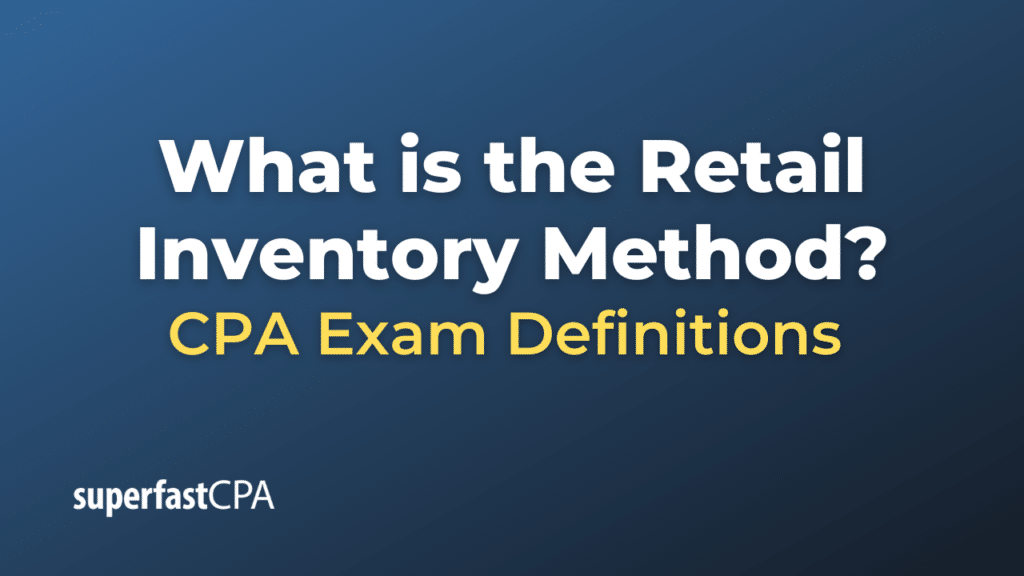Retail Inventory Method
The Retail Inventory Method (RIM) is a technique used by retailers to estimate the value of their ending inventory using a ratio based on the relationship between the cost and retail price of merchandise. This method is especially useful when dealing with large quantities of rapidly changing inventory, as is common in retail industries.
The primary advantage of the RIM is that it allows businesses to determine the ending inventory value without conducting a physical count of every item in the inventory. While it’s still essential to perform periodic physical counts, the RIM helps maintain reasonably accurate interim financial statements.
Here’s a step-by-step breakdown of how the Retail Inventory Method works:
- Calculate the Cost-to-Retail Percentage:
Cost-to-Retail Percentage = Total Cost of Goods Available for Sale / Total Retail Value of Goods Available for Sale - Determine the Retail Value of Ending Inventory: This can be done by taking the beginning inventory at retail plus retail purchases, less sales, and known inventory shrinkage (due to theft, damages, etc.).
- Estimate the Cost of the Ending Inventory:
Cost of Ending Inventory = Retail Value of Ending Inventory × Cost-to-Retail Percentage - To determine the Cost of Goods Sold (COGS) during the period, subtract the estimated Cost of Ending Inventory from the Total Cost of Goods Available for Sale.
A few things to note about the Retail Inventory Method:
- It provides an estimate, so periodic physical inventory counts are still necessary to adjust for discrepancies.
- Changes in pricing strategies or markdowns can impact the accuracy of the RIM.
- There are variations of the method, such as the Average, LIFO (Last In, First Out), and FIFO (First In, First Out) retail inventory methods, to account for specific inventory flow assumptions.
- The RIM is acceptable for financial reporting and tax purposes as long as the results approximate the actual physical inventory count results.
Example of the Retail Inventory Method
Let’s walk through an example using the Retail Inventory Method:
FashionForward Boutique sells trendy clothing. At the beginning of the month, they want to estimate their ending inventory without doing a full physical count. Here’s the data:
- Beginning Inventory:
- At Cost: $10,000
- At Retail: $20,000
- Purchases during the month:
- At Cost: $50,000
- At Retail: $100,000
- Sales during the month:
- At Retail: $90,000
Step 1: Calculate the Cost-to-Retail Percentage:
Total Cost of Goods Available for Sale = Beginning Inventory at Cost + Purchases at Cost
= $10,000 + $50,000
= $60,000
Total Retail Value of Goods Available for Sale = Beginning Inventory at Retail + Purchases at Retail
= $20,000 + $100,000
= $120,000
Cost-to-Retail Percentage = $60,000 / $120,000
= 0.50 or 50%
Step 2: Determine the Retail Value of Ending Inventory:
Retail Value of Ending Inventory = (Beginning Inventory at Retail + Purchases at Retail) – Sales at Retail
= ($20,000 + $100,000) – $90,000
= $30,000
Step 3: Estimate the Cost of the Ending Inventory:
Cost of Ending Inventory = Retail Value of Ending Inventory x Cost-to-Retail Percentage
= $30,000 x 0.50
= $15,000
Step 4: Determine the Cost of Goods Sold (COGS):
COGS = Total Cost of Goods Available for Sale – Cost of Ending Inventory
= $60,000 – $15,000
= $45,000
Conclusion: Based on the Retail Inventory Method, FashionForward Boutique estimates its ending inventory at a cost of $15,000 and a COGS of $45,000 for the month. Remember, while this method provides an approximation, a physical count is necessary periodically to ensure accuracy.













